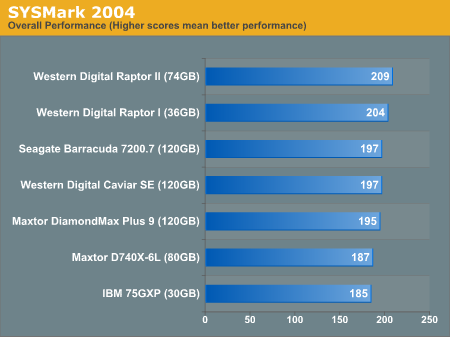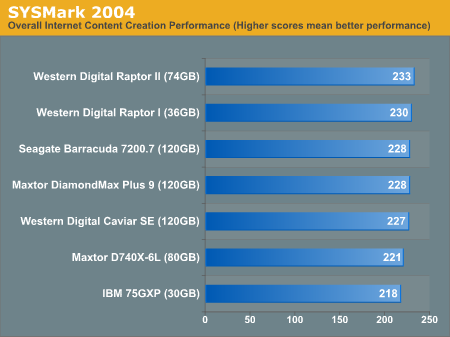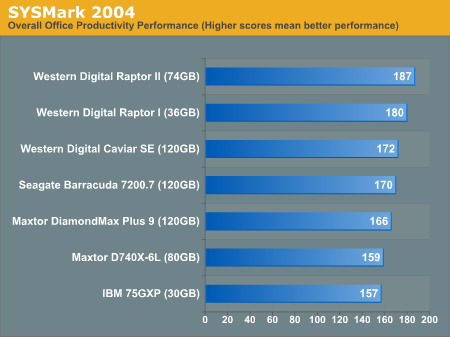Q2 2004 Desktop Hard Drive Comparison: WD Raptor vs the World
by Anand Lal Shimpi on June 7, 2004 12:05 AM EST- Posted in
- Storage
SYSMark Performance Summary
The overall SYSMark scores summarize what we've seen thus far:

As a recap, here's what happens with the Internet Content Creation suite:
"In this scenario, the content creator creates a product-related website targeting a broadband and narrowband audience. The user first renders a 3D model to a bitmap, while preparing web pages using a web site publishing tool. The user opens a video editing package, creates a movie from several raw input movie cuts and sound cuts and starts exporting it. While waiting on this operation, the user imports the rendered image into an image-processing package, modifies it and saves the results. Back in the 3D modeling software, the user modifies a 3D model and exports it to a vector-graphics format. Once the movie is assembled, the user edits it and creates special effects using one of the modified images as input. The user extracts content from an archive. Meanwhile, he uses an animation creation tool to open the exported 3D vector graphics file. He modifies it by including other pictures and optimizes it for faster animation. The final movie with the special effects is then compressed in a format that can be broadcast over broadband Internet. The web site is given the final touches and the system is scanned for viruses."

In the Internet Content Creation tests, we see that although there is a difference in performance between current and previous generation hard drives, there's very little that separates the 10,000RPM Raptors from the 7200RPM drives.
Also recapping, here's what happens in the entire Office Productivity suite:
"In this scenario, the office productivity user creates a marketing presentation and supporting documents for a new product. The user receives email containing a collection of documents in a compressed file. The user reviews his email and updates his calendar while a virus checking software scans the system. The corporate web site is viewed and the user begins creating the collateral documents. The user also accesses a database and runs some queries. A collection of documents are compressed. The queries' results are imported into a spreadsheet and used to generate graphical charts. The user then transcribes a document. Once the document has all the necessary pieces in place, the user changes it into a portable format for easy and secure distribution. The user edits and adds elements to a slide show template. Finally, the user looks at the results of his work (both the slide show and the portable document) in an Internet browser. "

Office Productivity paints a much different picture, with significant advantages being seen over older drives. The Office Productivity suite also paints a much more compelling picture of the Raptors' performance; even the older Raptor manages to maintain a decent performance advantage over the cream of the crop 7200RPM 8MB Parallel ATA drives.
Overall performance is an average of the two suites, and thus, we see that a lot of the impressive performance gains in Office Productivity are diluted by the relatively little variation in Internet Content Creation performance.










50 Comments
View All Comments
T8000 - Monday, June 7, 2004 - link
One point I did not see in the review was the partition information.This may be important, because smaller partitions usually perform better, because of their smaller allocation table and possibly even a smaller cluster size.
It would be best to use a drive image that fits on all drives and load it on each drive for testing, to make sure smaller drives are not given an advantage over bigger drives and fragmentation is the same for all drives.
Did you use this method?
broberts - Monday, June 7, 2004 - link
It would be nice if you included the actual model numbers of the tested drives.Perhaps I'm missing something but ISTM that comparing benchmarks of SATA drives against those running at PATA-100 is questionable. Especially since most of the numbers reported are within 5% of each other. Why weren't SATA models of the 8MB/7200 drives used?
jrphoenix - Monday, June 7, 2004 - link
I have submitted my request to Anand. I would like to see the new Seagate and Hitachi drives. The new 7200 rpm Seagates (shipping this month) support NCQ and are supposedly quicker than the raptors at a lower price!!! :)Crassus - Monday, June 7, 2004 - link
Anand,I would have liked to see also the performance of 2 Raptors of both generations in RAID 0, at least with the integrated controllers (ICH5 etc.).
Nighteye2 - Monday, June 7, 2004 - link
It's good to see this test, but why are the raptors the only SATA drives? It would be good to add in a SATA WD 7200 RPM 8 MB drive (80 GB, 120 GB, or another size)trexpesto - Monday, June 7, 2004 - link
Since with buying technology part of the equation is how long to hold off, it would be cool to get a head's up on stuff in the pipeline like the NCQ/TCQ drives.http://www.seagate.com/cda/newsinfo/newsroom/relea...
Apologiliac - Monday, June 7, 2004 - link
I was startled how quiet the seagate was, because i was wating for it to turn on (?...!) I was also laughing out loud after the new raptor played because it immediately followed by gangsters paradise by weird al on my playlist :pdeathwalker - Monday, June 7, 2004 - link
I am somewhat dissapointed that this review did not include at least a couple of competing SATA drives...such as maybe a Seagate and Maxtor drive. The majority of the community already assumes the advantages of SATA over PATA!!Blain - Monday, June 7, 2004 - link
A 75GXP? You gotta be kiddin'Why not run the other drives against a new Hitachi?
For crying out loud! :o
Z80 - Monday, June 7, 2004 - link
Your review was right on target for my needs. I was considering upgrading my 120GB Maxtor to a new WD 74GB Raptor. Looks like I can save my money now or spend it on an upgrade that gives more bang for the buck. Thanks